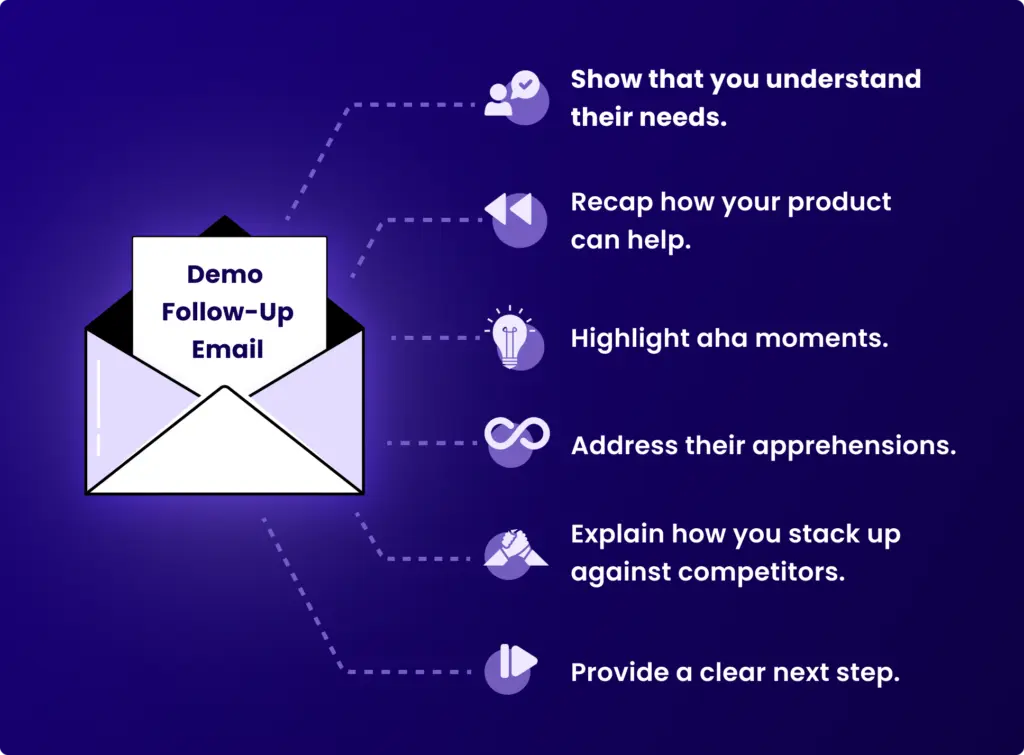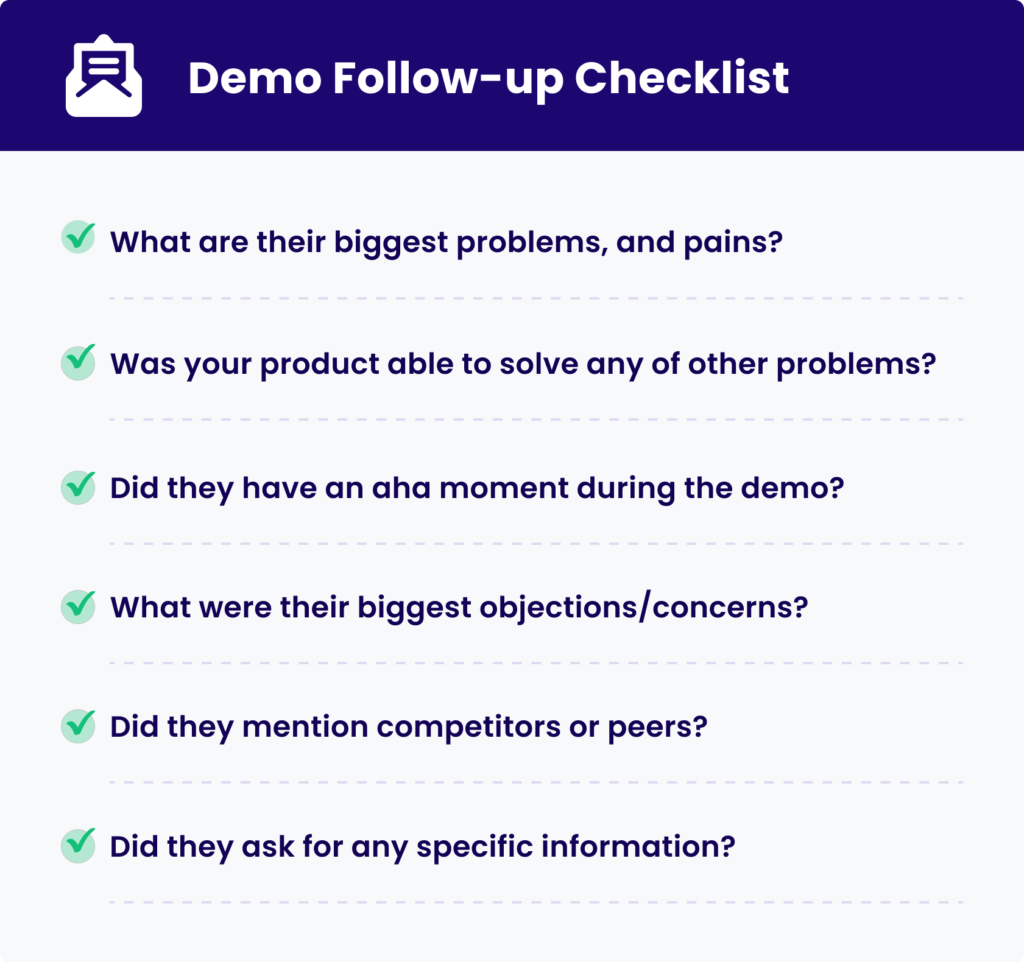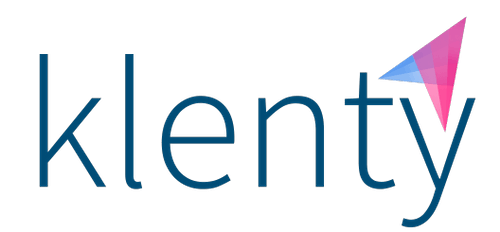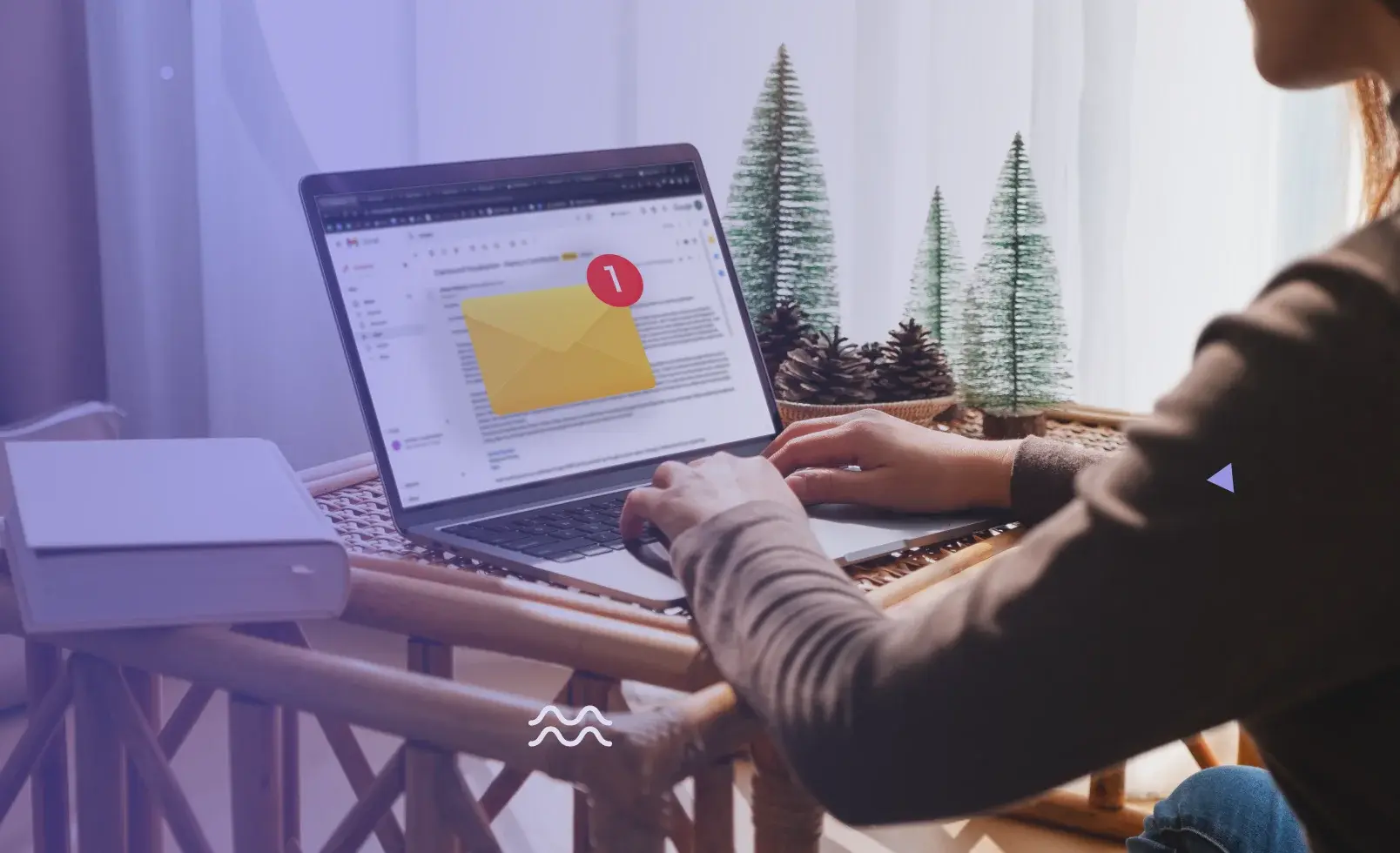What’s common between won deals and pro tennis serves? Both bring in money and recognition. But, if you look closely, it’s the consistent follow-ups on deals and the crack-of-dawn practice sessions that made it happen.
It’s not hard to see why 80% of sales require five follow-ups. Even if your demo or sales meeting was pitch-perfect, what comes after is just as important. A follow-up after a demo is critical because they help you make the most of both the momentum built during the demo and the mind space your prospects have for your product at the time.
In this article, we do a deep dive into how you can create winning follow-up emails, the best practices for writing them, and templates you can use right away.
Let’s get started.
Download Now: Demo Follow-up Email Guide
[Free Access]
What Is a Demo Follow-up Email?
A sales follow-up email is not another opportunity to pitch your product or explain its one hundred features. It is an important stage in your selling journey that pushes the prospect to the next stage whether that is a free trial, a purchase, or further qualification, by:

The Different Scenarios After the Demo That Need a Follow-up Email
This varies depending on your product, the customer’s needs, their current budgets, and your product/service’s current capabilities.
In most cases, the goal of a post-demo follow-up email could be to:
- Get prospects to commit to a free trial (or pilot).
- Address any unanswered apprehensions or technical queries.
- Conduct another technical or POC demo.
- Understand their purchase intent, and timelines, so you know where to add them in your nurturing sequence.
- Share your product or service’s feature pipeline, in case your offering doesn’t have the particular feature or service that solves their current problem.
Post-Demo Information Checklist
- Summarize the demo discussion right after the session while it is fresh in your mind. Watch the demo recording to note all the major pain points during the call and map them to the solutions you provide.
- Maintain a Q&A checklist for your demos. Here's an example.

- Research the competitors they might be potentially looking at and revisit your sales enablement content.
- Lastly, decide what the goal of the follow-up email should be, based on the above steps.
7+ Demo Follow-up Email Templates You Can Use
Template #1: Free Trial Follow-up
This template is designed to help you ride the momentum of a smooth and successful demo. The next step would be to cement this positive experience with a free trial and/or a hyper-care phase, so your customers feel confident and supported when they start their journey with your product.
Subject line: After the demo, it's time for installation!
Hello, {Name}
Thank you, {name}, and {the respective team} (if there was more than 1 member) for making your pain points crystal clear. We’re pumped that you found {product} and had to look no further.
Here's a quick note of your issues and how we can solve them for you. Just to make sure we're on the same page before we get started.
Problem and Solution #1
Problem and Solution #2
I will set you up with a free trial and a dedicated team. They will give you a quick crash course to turn you into a master in no time!
For now, here’s how to use {the primary feature they loved}. I’m including a one-pager and a short video you can share with your team. I’m also sharing a few references to help you understand how teams like yours solved {their biggest challenge} using {your product}. Call it motivation, inspiration, or just plain facts.
Would you want to start testing {product name} from {day}? Let me know.
Have a good one!
{Salesperson’s name}
Template #2: The Info-Heavy Follow-up
This template focuses on addressing apprehensions or concerns that came up in the demo, to build your prospect’s confidence in your product and its ability to be exactly the solution they are looking for.
Subject line: Psst! We've got the information you wanted
Hi {Name},
We're grateful for the valuable time you spent yesterday taking me through your challenges. I'm back to address your query about helping with (challenge). Let's quickly recap our conversation. Question/Answers 1, 2, and 3.
After a quick trip to the idea room with our team, here's what we came up with.
Question / Answer #1
Question / Answer #2
Question / Answer #3
I can set you up on a trial account so you can experiment with the product first-hand.
You won't be alone. Our technical experts will be there to guide you through all of it.
Please let me know when you’d like to get started.
Cheers,
{Salesperson’s name}Template #3: The Take-Two Follow-up
Any salesperson will know how tricky and stressful sales demos can be. Whether it is technical glitches during your demo or just an off-color day for you, there could be demos that leave you feeling like you missed hitting the right spots.
So, what do you do? For starters, don’t let one bad demo get you down. Pick yourself up and move on to the next step. Then, follow up with this do-over template.
Use this template to share your demo slides (or video explanation of how your product/service can solve their biggest pain point) so you can be sure you’ve managed to communicate the value of your offering, sooner or later.
Or if you’re feeling adventurous, ask for another demo, say for a larger group, or a focused one for a smaller team, so you have another shot at showing your prospect how you can help.
Sub: Here's (product name), the antidote to (specific challenge). Let's administer it together!
Hello {Name},
I must say, that was a really insightful session we had yesterday. Your insights have helped me understand precisely the challenges you aim to overcome. My team here is gearing up to catapult you over (challenge(s)) and across the finish line.
My product expert is on standby for you. Please let me know a time and date of your convenience, so we can walk you through the success strategy we've prepared for you.
Meanwhile, I’ve attached the full slide deck and a custom report for your use case. Feel free to share this with the team.
So, {name}, would you like to kick {product/service}’s tires? If yes, please block your choice of time here on my calendar.
Cheers,
{Salesperson’s name}Template #4: The ‘Uncovering Urgency’ Follow-up
Sales expert and author J Barrows rightly says, "You can’t create urgency but you can uncover and drive it."
This template adopts this principle to guide your follow-up approach. It relies on your ability to quantify and explain why they need to act fast, instead of creating a false (and let’s be honest, easy to see through) sense of urgency through limited period offers and discounts.
Use this template when you’re able to quantify exactly how much not solving a problem can impact them. This is best paired with a quantitative case study or customer testimonial.
Sub: What if you could save X dollars on every customer? (Not rhetorical)
Hi, {Name}
Yesterday, I had a great time showing you how our product can work for you. Special thanks to you and your team for making this happen.
Getting to the point, our calculations show that you could be overspending by 30% for every {instance or activity}.
We can help you get in the driver's seat right from Day 1. Here's how:
Approach 1 and benefit
Approach 2 and benefit
Approach 3 and benefit
I’m also sharing a case study on how {client name} achieved Y% savings with a use case similar to yours.
I’m excited to hear if you have any other areas you’d like to focus on, so we can put them on our to-do list right away.
Cheers,
{Salesperson’s name}Template #5: The Consultative Follow-up
This template uses consultative selling. And sometimes, even a challenger sales approach can bring more to the conversation than what was discussed in the demo. Here’s how:
- Pitch a few unique ways your product can help.
- Even better, identify a problem they haven’t realized of yet. But, you’re sure it will surface, based on your experience.
Sub: You cannot avoid (challenge). Or, can you? Here's a hint: (approach to challenge)
Thank you again for such an interactive and useful session demo yesterday. I'm already fired up and buzzing with ideas for our plan of action.
You have a unique use case, and here are a few specific ways (product) can make things a lot easier.{list of approaches/ use cases}.
I also noticed the {ignored problem}. While I can see that (potential issue) is not a major concern right now, I did notice (ignored problem and its effects).
I could also set up a 45-minute workshop with our team to brainstorm how we can use {product} to solve your current problems and the ones that may arise in the future.
Our team is available from {timeslot} next Wednesday. Let us know how we can fit into your schedule.
Cheers,
{Salesperson’s name}Template #6: Further Discovery Follow-up
This template is designed to help you understand your prospect’s purchase timeline so you know where to place them in your lead nurturing workflow. The key is to limit the ask to one detail so you don’t appear too pushy.
Jed Marhle, the creator of The Practical Prospecting Newsletter has another useful piece of advice: use the word "because" in your communication. A foundational research study at Harvard found that using the word "because" in requests resulted in significantly better responses – even when the reason wasn’t particularly compelling.
Subject line: A quick question, please?
OR {Name}, can you please help me with something?
Hello, {Name}
Thank you, {name}, for such an engaging and insightful demo. I couldn’t help but be amazed by the clarity and focus with which your team operates.
I just had one quick question for you – would you be able to share your timelines for closing this decision?
I’m asking because we have a few useful features in our product pipeline and I was hoping to make them work with your timelines.
Looking forward to hearing from you,
{Salesperson’s name}Template #7: The Product Pipeline Follow-up
It’s not rare to leave a demo with product or service feature requests from prospects. Depending on how their requirements align with your product’s current priorities or feature pipeline, here are a couple of templates you can use.
Scenario 1: When the prospect’s requirements are feasible
Subject line: Great news, we can make this work!
Hello, {Name}
Thank you, {name}, and {the respective team} (if there was more than 1 member) for your time and input yesterday.
I have a much better understanding of your requirements now – which brings me to the good news.
Our feature pipeline has just what you need to fix your {current problem}. We should be able to roll this out to you in {specific timeline}.
For now, here’s a one-pager you can share with your team on what this will look like.
I’m doing my best to fast-track this process for your team. I’d be excited to hear if you have any other areas you’d like to focus on so we can add them to our pipeline right away.
Sincerely,
{Salesperson’s name}Scenario 2: When your product is unable to meet your prospect’s requirements.
Subject line: {Name}, I have the answers you needed
Hello, {Name}
Thank you, {name}, and {the respective team} (if there was more than 1 member) for yesterday’s meeting. It has helped me get a much better understanding of your unique challenges.
It turns out that {the feature requested} is not part of our current feature set. However, we have added it to our feature pipeline, and I should have an update for you by {timeline}.
In the meantime, I could also set up a 45-minute workshop with our team to brainstorm how you can use {product}’s current features to solve your problem.
Our team is available from {timeslot} next Wednesday. Let us know how we can fit into your schedule.
Sincerely,
{Salesperson’s name}Best Practices for Writing a Demo Follow-up Email
1. Say ‘Thank you’
Thank the customer for their time and participation. Make sure to include something you learned or discovered about them (or their organization) as part of your email. Besides bringing in the element of personalization, it also shows them how invested you were/are in the conversation.
2. Don’t ‘touch base’
Don’t say you’re reaching out to ‘touch base’ or ‘check in’, you won’t sound any different than the hundred other emails that start the same way. “When you are just checking in, you are just following up to follow up. You are making it about you, and that’s a huge mistake,” says James Troiano, in the Stuff About Sales podcast he co-hosts. ‘Check-in’ follow-ups give an “incongruent message to the prospect,” especially when you have communicated with them along the lines of “I am in this for you, or I wanna do this on your timeline,” adds James. It makes them think that suddenly it is no longer about them.
3. Follow the ‘rule of three’ principle
Limit your email to a maximum of three main talking points. The popular rule of three is a principle that says that things in groups of three are more effective than other numbers. This rule is effectively used in multiple spheres of life, such as poetry, oral storytelling, films, photography, and advertising. Using this in your follow-up email ensures that you don’t overwhelm your prospects or risk burying important information.
4. Add a clear CTA
Whether you’re offering them a trial, conducting another demo for a different team, or settling the deal, make it clear what action you expect from their end.
5. Don’t miss your window of opportunity
Send a follow-up within 24 hours because the demo is still fresh in your prospect’s mind. If you’re in a competitive market, getting to them before others or the speed at which you get their attention could be the difference between a won or lost deal.
6. Use the right sales enablement content
Whether it is mini-feature demos, battle cards for competitive analysis and comparisons, customer win stories, or case studies, make sure you have these handy to support the different demo follow-up emails you might need to send out. In case you missed it, check out our complete guide to creating sales enablement content for your sales journey.
7. Give your follow-up the time and attention it needs
Your follow-up email and sales demo are two different and distinct stages. And your customers should be able to see and experience this – be it in the script/language you use, your assets or resources, or in the attitude you adopt at each stage.
The discovery call is all about listening and understanding, while the demo could lean towards showing and telling. But your follow-up should be about recapping (not repeating), clarifying, and influencing.
So, Are You Ready To Follow Up With a Winning Attitude?
We can’t stress this enough: a follow-up email is NOT a good-to-have tick box in your checklist. It is a critical part and stage in your selling journey – one that influences your prospect to move to the next stage – be it a free trial, a purchase, or further qualification.
Equally importantly, it’s NOT an exercise of who persuades them better.
As Andy Paul, author of Sell Without Selling Out, says, “Having an influence mindset rather than a persuasion mindset alters the nature of how you interact with a buyer. Influence has a positive impact on the experience your buyer has with you. In contrast to the universal human resistance to being pushed, prodded, and persuaded.”
Each time you’re tempted to use follow-ups as a way to coax or persuade prospects into a purchase, take a step back to remember that the best sales stories are about helping customers succeed.
And so are the best follow-up emails.

